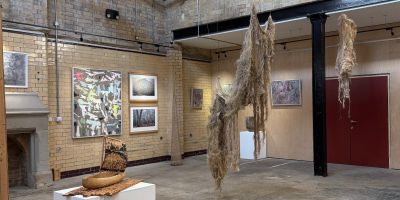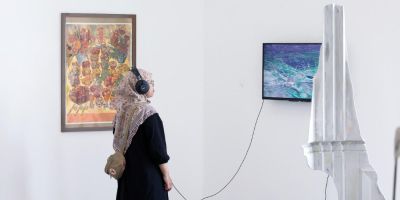Dr Louise Atkinson awarded funding for participatory art project to explore Chinese wallpaper at Harewood House

PhD alumna and Visiting Research Fellow, Dr Louise Atkinson, has been awarded funding to co-produce artwork in response to the Chinese wallpaper at Harewood House.
Currently based in the School of Fine Art, History of Art and Cultural Studies, Atkinson is a visual artist, researcher and facilitator. Her practice-based doctoral research at the University of Leeds explored how artists incorporate elements of museum practice and ethnographic objects into their work.
Building on this research, Dr Louise Atkinson’s latest project – If Walls Could Talk – considers what the Chinese wallpaper at Harewood House means to Chinese-speaking communities and the wider Asian diaspora in Leeds today.
The wallpaper was installed by Thomas Chippendale in 1769, after arriving from the trade port of Canton in southern China. As an object made by Chinese artisans for export to the European market, the wallpaper occupies an interesting space in art history. It raises important questions about the nature of (self-)representation in decorative art, and the impact of trade and imperialism on its production and reception.

East Bedroom at Harewood House, with Chinese wallpaper and Chippendale chinoiserie furniture. Image credit: Harewood House Trust.
Louise’s work often incorporates processes of co-production and co-curation, creating new narratives with other people in response to existing archives, collections and histories. In addition to her visual art practice, she is a founder and co-Director of The Highrise Project CIC, an organisation committed to supporting marginalised and minoritised communities in Leeds through art and digital inclusion.
Louise said:
“As a researcher with a practice-led PhD in Fine Art, I often work with community participants to explore themes of representation through objects and images. By collaborating with Chinese-speaking groups in Leeds, the project aims to address these themes while opening up spaces, traditionally coded as British, to more diverse audiences.
“I will be working with Lychee Red Chinese Seniors, Hongkongers, Beetey Din and Leeds Chinese Community School to create an augmented reality (AR) experience, which will be showcased in 2025 in the East Bedroom at Harewood House.
“Alongside the AR experience, the project will include a dedicated website, AR postcards, and a publication featuring images and insights from the participants and workshops.”

No One Is An Island (2023), an augmented reality map co-created with refugees, asylum seekers and migrants with The Highrise Project as part of University of Leeds' Welcoming Migrants programme. The project was commissioned by Leeds University Library Galleries to respond to the 2023 'Shifting Borders' exhibition in the Treasures of the Brotherton Gallery.
Beyond reinterpreting the imagery within the Chinese wallpaper, the project critically examines its connections to Harewood’s colonial history and the broader implications of global trade in the 18th and 19th centuries.
Louise explained:
“The Chinese wallpaper would have been brought to England on an East India Company (EIC) ship, as part of a consignment of luxury goods including porcelain and lacquerware.
“It was traded privately by East India Company officers, and this, as well as the expense of producing and transporting it, meant that it was only available to a privileged few. The owners of Harewood, as Directors and officers of the EIC, would have had direct access to this trade.”

Chinese wallpaper in the East Bedroom at Harewood House, including detail of decorating and glazing the fired bowls (right). Image credit: Harewood House Trust.
The project is supported by community artist Cassy Oliphant, curator Jocelyn Anderson-Wood (Harewood House) and academic Dr Robert Knifton (School of Fine Art, History of Art and Cultural Studies at the University of Leeds).
Translation is provided by students from the MA Art Gallery and Museum Studies and MA Arts Management and Heritage Studies programmes in the School of Fine Art, History of Art and Cultural Studies. Working with MA students from the school offers emerging professionals experience in community-based art projects, while enhancing language accessibility for the groups and wider audiences.
The project is generously funded by Arts Council England Project Grants, Leeds Cultural Investment Partnership and the Merryl Huxtable Bursary 2024 (awarded by the Wallpaper History Society).

Chinese wall paper in the East Bedroom at Harewood House (turning dishes and plates). Image credit: Harewood House Trust.
Dr Robert Knifton, University Academic Fellow in Critical Studies in Museums, Galleries and Heritage, said
“With Louise's astute leadership guiding the project, If Walls Could Talk, is surfacing a whole host of fascinating and productive conversations around cultural and institutional exchange, dialogue and memory.
“Witnessing the group of Hong Kong participants engage with Chinoiserie at English stately homes, hosted in the Treasures of the Brotherton Gallery at University of Leeds, brought home the potential of this project to initiate community participatory practice in Leeds and beyond.”

Detail from Chinese wallpaper in the East Bedroom at Harewood House. Image credit: Harewood House Trust.
Rowena Beighton-Dykes, Honorary Chair of the Wallpaper History Society and editor of the Wallpaper History Society Review, said:
“The Wallpaper History Society is committed to supporting research projects which contribute to knowledge in the field. The bursary is usually awarded for archival research or practical conservation work.
“However, at the 2023 Annual General Meeting, we agreed that we needed to reflect a wider audience and demographic within the bursary outputs, and we felt that Louise’s novel approach to wallpaper research would offer a much more interactive engagement with the subject of Chinese wallpaper.
“Louise’s recent article for the Wallpaper History Society Review 2024 emphasised that wallpaper should never be dismissed as mere background material, championing the mission of the Wallpaper History Society, as well as my own views on the subject.”
Published in September 2024, Louise’s article — 'Souvenirs of History: The Duke of Wellington wallpaper at Burton Constable Hall' — explored the relationship of the wallpaper to its cultural and political landscape of the time.

Duke of Wellington wallpaper in the Waterloo Room at Burton Constable Hall. Image credit: Burton Constable Hall.
Jocelyn Anderson-Wood, Curator at Harewood House, said:
“The team at Harewood House Trust are so thrilled that this project is going to engage visitors with one of the most amazing features of the house in a new and exciting way.
“We can’t wait to see the final AR experience.”
The project expands on Louise’s previous artistic and ethnographic research alongside other academics, including Dr Claudia Sternberg (University of Leeds), Professor James Simpson (Hong Kong University of Science and Technology) and Dr Jessica Bradley (University of Sheffield).
Louise is also co-authoring a monograph with Dr Bradley based on their previous work in linguistic and semiotic landscapes with multilingual young people in Manchester. The publication, titled The Art of the Linguistic Landscape, will be published by Multilingual Matters in 2026.

Multilingual Streets (2019-2021), a project working with multilingual pupils at two high schools in Manchester, and led by Multilingual Manchester and Dr Jessica Bradley from the University of Sheffield.
More information
Follow If Walls Could Talk on Instagram @ifwallscouldtalk.
Find out about Dr Louise Atkinson’s research and practice.
Feature image
Chinese wallpaper in the East bedroom at Harewood House with detail of chopping planks for tea crates (foreground). Image credit: Harewood House Trust.




